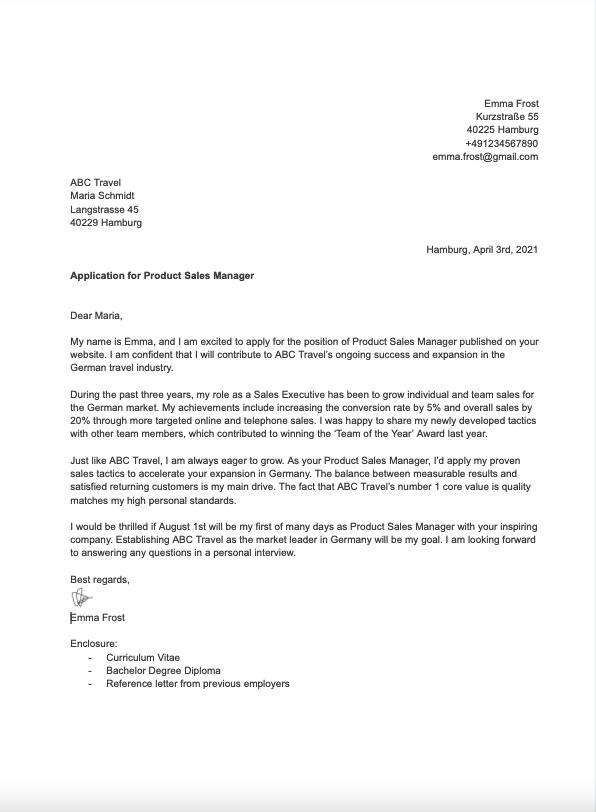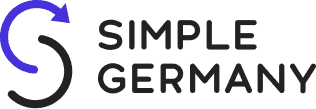A cover letter (Anschreiben) might be the least important thing of the application in some countries; however, not so in Germany. Depending on the company and recruiter receiving your application, a German cover letter might be the most essential part after your CV.
A survey of HR Recruiters in Germany states that 42% ignore an application without an individual cover letter. The same survey also shows that for 71% of HR, a cover letter is an essential document in a job application. A job application letter conveys your level of professionalism, research capabilities, and ability to sell yourself without much fluff.
Simple German cover letter sample in English
A cover letter in Germany (Anschreiben) needs to complement your CV, but not repeat it. You can regard a cover letter as a letter of motivation filled with examples and facts. A cover letter in Germany is a very formal document that should follow a particular layout.
Read Our Related Guide
Our German-Style CV Template In English helps you to craft a killer CV. We have also created a German cover letter sample in English for you to understand what your finished document should look like.

To save you loads of time, we created a cover letter template + tutorial video.
Click here to get our Cover Letter Template
How to write a cover letter in Germany?
We will walk you step-by-step through the areas you should include in a German cover letter. You will also learn about what the content of the cover letter should convey.
German cover letter formal format
As mentioned before, the German cover letter is a very formal letter that should follow the following format for it to look familiar to the German eye:
- Maximum one page and don’t fill it up completely. Leave enough white space when glancing over it.
- Put your full address, including email (ideally including your name) and phone number, in the top right corner.
- Put the company’s full address on the left with one paragraph below your address. Include the name of the contact person in the second line.
- Place the date of your application right-aligned underneath the addresses.
As you might know already, Germany has tons of rules, regulations, and guidelines. Naturally, there is also a guideline for professional letter writing and correspondence, the so-called DIN 5008 norm. It states the following margins on a DIN A4 (standard German letter paper format):
Left margin: 2,5 cm
Right margin: 2,0 cm
Top margin: 4,5 cm
Bottom margin: 2,5 cm
Please take this information with a grain of salt. Not following this layout does not mean that any German manager or recruiter will ignore your cover letter; however, the German eye is trained and used to reading this format. Anything appearing too much out of the ordinary might get noticed negatively. Again, you can shine with your cover letter’s content, but don’t try to stand out with the format unintentionally.
1. Subject Line
The subject line in a German cover letter needs to stand out. It needs to convey with one look what position you are applying for, and you should bold it.
2. Salutation
The salutation is extremely important – the more personalized, the better. Reflect your understanding of the company’s culture by using the first name or last name; however it is appropriate. If you can’t find enough information or are unsure, always refer to the last name. If you can’t find the relevant person’s name, don’t be shy and pick up the phone to find out more. This shows initiative and determination.
3. Content
When it comes to the cover letter’s main body, you should try to stick to four paragraphs. Remember to point out what value you will bring to the company, not what you can get from the company. Your cover letter’s content needs to reflect the expectations and requirements mentioned in the job ad. So make sure to connect the dots and position yourself ahead of other candidates.
Introduction (3 – 4 lines)
The introduction should answer why you are applying for the position and how you became aware of it (through a friend, an employee at the company, a job portal, etc.). Be confident in your word choice. Don’t use insecure words such as ‘I think I would be a good fit’ but rather ‘I am confident that I will contribute to …’.
Second paragraph (5 – 6 lines)
Now it is time to shine with your skills, experience, and qualifications. Never just list things, but choose the relevant achievements and prove them with results. Don’t only refer to achievements in your work life, but if relevant, also mention efforts with private projects. This will show your personality, drive, and willingness to learn and grow beyond what you get paid for. It is absolutely ok to also write in bullet list style in this part, as long as you don’t just list things.
Third paragraph (5 – 6 lines)
After you have showcased yourself, it is time to translate how these experiences and skills will contribute to the role and company. Convey that you have taken the time to research the company by referring to the company culture, possible awards the company has won, or projects that inspire and motivate you. Be authentic and confident.
Closure (3 – 4 lines)
To close your cover letter:
- Reemphasize your eagerness to join the company in the relevant position.
- Describe your future goals and the value you can bring to the company.
- State when you will be available to start work.
- Emphasize that you’d be happy to answer any questions via phone or in a personal interview.
- Only mention salary expectations if they are asked for in the job ad.
- Be sure to sign the cover letter with your name.
4. Attachments
Add the word ‘Enclosure’ (Anlage) underneath your signature. List all the additional documents you will hand in with your application, like your CV, certificates and diplomas, reference letter, etc.
Further cover letter and job applications tips
Tip No. 1
Don’t use the same CV and cover letter for different applications. As mentioned above, you must individualize your application to each company’s needs and requirements.
Tip No. 2
If you send your application directly by email, you have two options. You can either make the email body your cover letter. In this case, remove the address and date part from the email and place the subject line in the email’s actual subject. The body of the email remains a formal letter, though.
Or you can attach the cover letter to the email and briefly point out your application to the specific position in the body of the email, referring to the attachments.
Ensure that any attachment always has the pdf format, regardless of whether you send it by email or upload it to an online application system. Also, pay attention to the naming of the attachments and keep it clear and professional.
Tip No. 3
Your job application, namely your resume and cover letter, should answer the recruiter’s main three questions:
- Can you do the job? (Skills)
- Will you do the job? (Motivation)
- Will you fit in with the company culture? (Personality)
Be sure to evaluate your documents based on these questions before you hand them in. The goal of your CV and cover letter is to get an invitation for a job interview.
Read Our Related Guide
Conclusion
We hope that you now have a better understanding of how a German cover letter looks and feels like. But never forget to adapt your cover letter and application to the style of the company you are applying for. There is a big difference in culture between a young international StartUp and a big traditional German enterprise.





